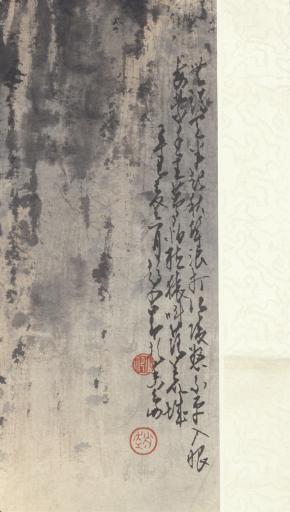Exhibition Label: “Conversation I: Place,” Oct-2007, Emily Stamey
The Three Gorges, China
The mighty Chang Jiang, also known as the Yangtze River, is the longest river in Asia and snakes through the region known as the Three Gorges. A place of magnificent natural wonder and immeasurable cultural memory, the Three Gorges encompass a relatively small region only 75 miles long. However the breathtaking landscape of precipitous cliffs, steep valleys, and perilous rapids has captivated countless generations of artists, who have immortalized the majestic landscape of the Three Gorges in poetry and painting.
The Three Gorges Dam-the largest hydroelectric river dam project in the world-will forever change this historic landscape. To make room for the colossal dam, which will flood an area measuring 395 square miles, 13 major cities, 140 towns and more than 1,300 villages, along with 1,600 factories and mines and an unknown number of farms had to be abandoned and 1.4 million people relocated by the time of its completion in 2009. The environmental impact of the Three Gorges Dam project will be immense, threatening everything from the breeding grounds of the Siberian Crane to causing erosion and sinking of coastal areas due to the blockage of the Yangtze’s large amounts of silt.
Without warning, autumn sounds fill half the sky.
The angry waves strike the waters and shores ceaselessly.
Lingering before my eyes are dreams of ten thousand miles away.
I dread the cries of gibbons echoing in the wilderness.
- Zhao Shao’ang
Inscription in Terese Tse Bartholomew et al., The charming Cicada studio: the masterworks of Chao Shao-an, San Francisco: Asian Art Museum of San Francisco, 1997, 170.
“Sunset at the Three Gorges was executed during the Asia-Pacific War (1937-45), when Zhao traveled extensively into the southwest parts of China. The spectacular natural wonders of the region left a deep impression upon the artist. Despite the ongoing warfare around him, Zhao found refuge in the timeless beauty of nature. Beyond the romantic rendering of the landscape, the painting also serves to evoke a nostalgic sentiment associated with the Three Gorges.”
- Ai-Lian Liu
Art History graduate student and former Spencer intern
Exhibition Label:
"Images of the Journey," Jun-2005, Hillary Pedersen
The Yangzi River runs almost 4,000 miles through south-central China, making it the third-longest river in the world. The most impressive section of the river is the Qutang, Wu, and Xiling gorges, collectively known as the Sanxia, or Three Gorges. Qutang Gorge is known for its steep, craggy peaks that line the riverbanks; Wu Gorge is known for its deep, serene waters; and Xiling Gorge is known for its perilous shoals and rapid currents. This area is one of the most popular tourist destinations in China, famed for the spectacular beauty of its misty mountain peaks and colorful landscapes. Zhao, celebrated for his use of bright colors, depicted the sky with a gentle peach hue and rendered the water and mountains with a faint blue in order to capture the splendor of the site.
In the early 1990s, the Three Gorges Dam project began, an endeavor that has caused a significant rise of the water level and a drastic reconfiguration of the landscape and riverside cities in the area.
Exhibition Label:
"Selections for the Summer," Jun-2006, Mary Dusenbury
In the 20th century, China experienced revolutionary zeal, brutal violence, the affirmation and rejection of tradition, fear, hope, despair, and dizzying radical changes. The four artists whose work is shown here interpreted the life of their times in very different ways: Ding Cong’s handscroll is a biting political satire; Zhao Yannian, another daring social critic, used his rough-carved woodblock prints to aid and celebrate the revolutionary cause; Zhao Shao-ang’s ink paintings evoke the past and the timeless beauty of nature and at first seem unrelated to the realities of contemporary Chinese life; Xu Bing plays with Chinese ideographs to comment on meaning and the distortion of meaning.
Zhao Shao’ang’s paintings evoke the timeless beauty of nature in a format and style that pay homage to time-honored painting traditions. His paintings appear far removed from the turbulence of the times. Zhao painted Sunset at the Three Gorges after he fled Hong Kong for Chongqing during the Sino-Japanese war of 1937-1945. He had sought refuge there when the Japanese invaded Hong Kong, but even that city, on the upper reaches of the Yangtze River, was under almost constant attack by Japanese fighter planes.
Rather than depicting the realities of living in the heavily bombed capital of the Republic of China, Zhao has focused our attention on the dramatic waterfalls of the Three Gorges near Chongqing. Perhaps his painting is meant to remind his viewers of the regenerative power of nature and turn their minds, at least briefly, from the destructive power of war.




